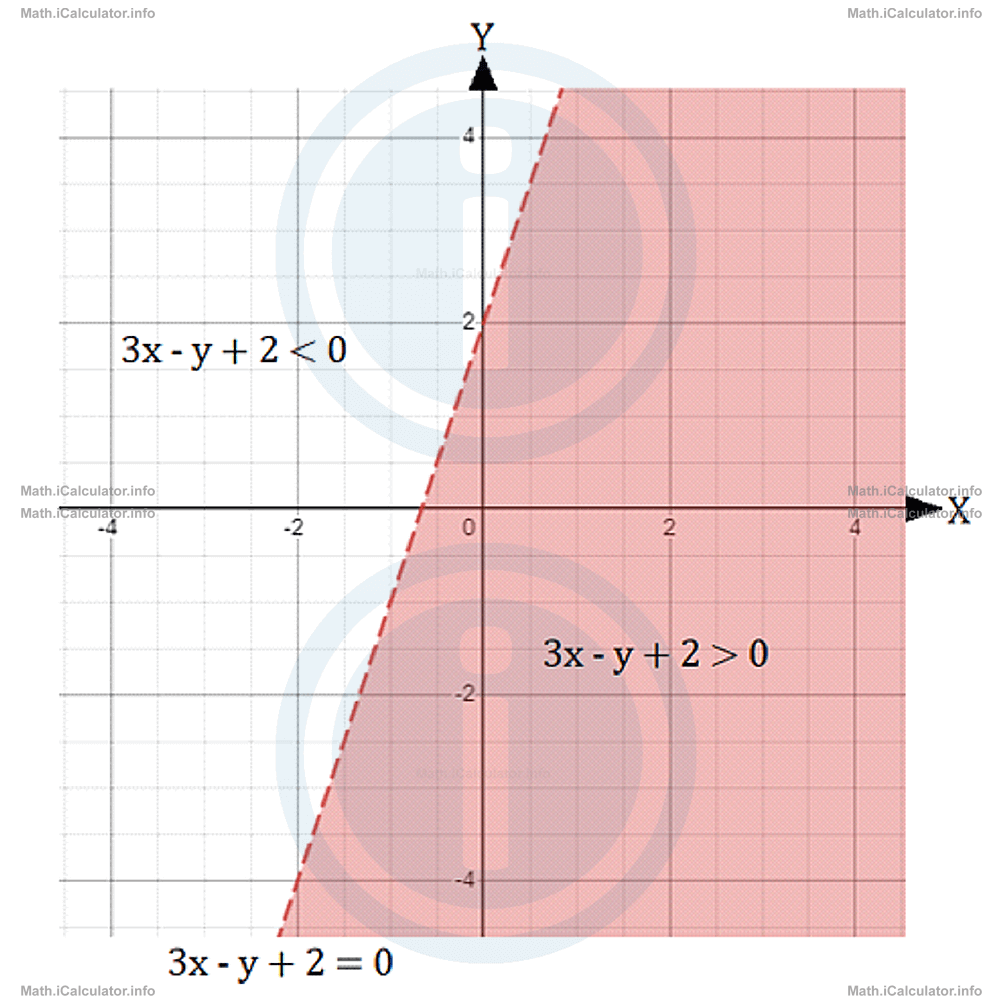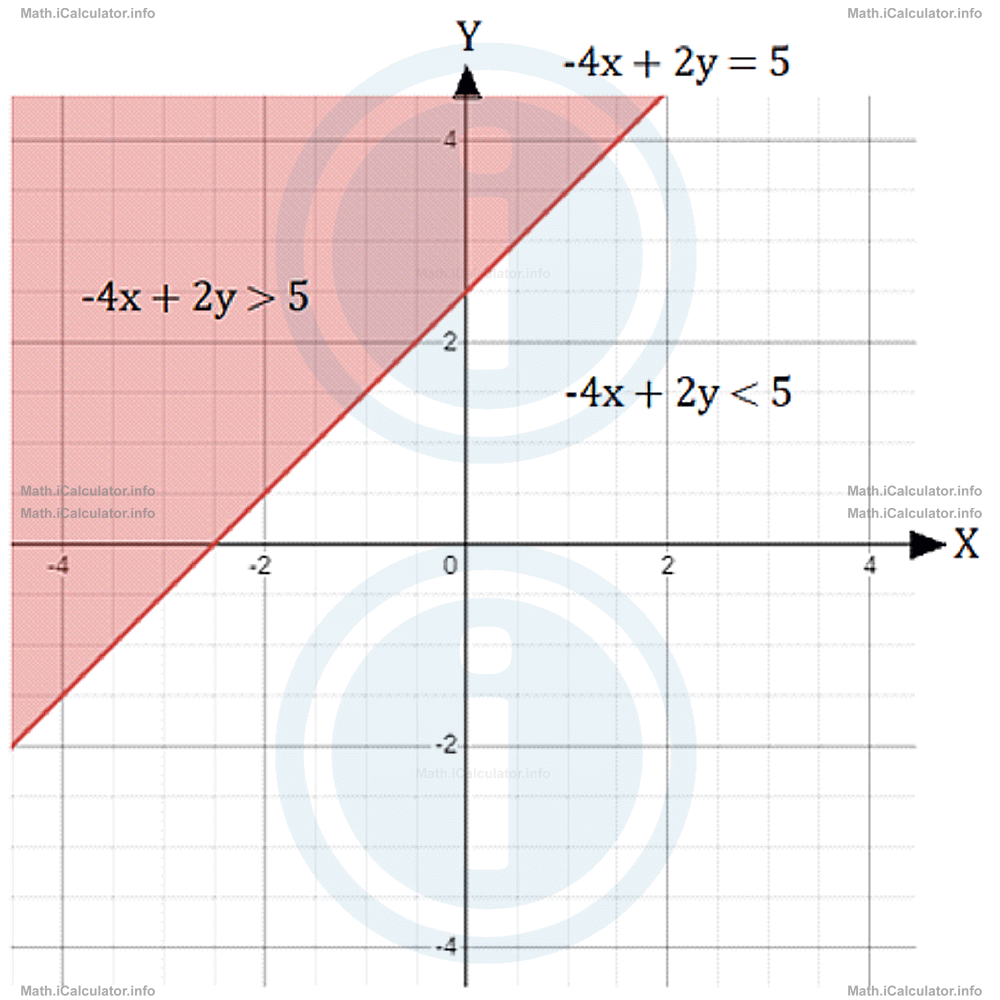Menu
Math Lesson 10.3.2 - Graphing First Order Inequalities with Two Variables
Please provide a rating, it takes seconds and helps us to keep this resource free for all to use
Welcome to our Math lesson on Graphing First Order Inequalities with Two Variables, this is the second lesson of our suite of math lessons covering the topic of Graphing Inequalities, you can find links to the other lessons within this tutorial and access additional Math learning resources below this lesson.
Graphing First Order Inequalities with Two Variables
From the theory explained in the previous tutorials, it is known that linear inequalities in two variables contain two variables at the first power. Their general form is one of the following
ax + by + c < 0
ax + by + c ≥ 0
ax + by + c ≤ 0
where a and b are coefficients, while c is a constant.
All of them derive from the corresponding linear equation with one variable
an equation which has a linear graph (hence the name "linear"). The slope of this graph (otherwise known as the "gradient") is obtained by the formula
As we know, another form of writing a linear equation with one variable is to isolate the variable y and write it in terms of the other variable x in the form
where m here represents the gradient k, while n is obtained by the formula
It is better to have the linear inequalities written based on the second form of the corresponding linear equation y = mx + n, as this form allows us to better locate the position of the solution set for that inequality. In this way, we obtain the following four possible linear inequalities with two variables:
y < mx + n
y ≥ mx + n
y ≤ mx + n
Thus, if we have the first linear inequality y > mx + n, the solution set includes all values (the zone) above the graph without the graph line, while in the second inequality y < mx + n the solution set includes all values (the zone) below the graph without the graph line.
On the other hand, the solution set of the third inequality y ≥ mx + n includes all values above the graph as well as those on the graph line, while the solution set of the fourth inequality y ≤ mx + n includes all values below the graph including those of the graph itself.
Let's consider an example to clarify this point.
Example 2
Find graphically the solution set of the linear inequality
- 3x - y + 2 > 0
- -4x + 2y ≥ 5
Solution 2
- First, let's express the inequality in the form y (?) 2mx + n for an easier solution. We have 3x - y + 2 > 0Reading the last inequality from right to left yields
3x + 2 > yy < 3x + 2In this way, we can identify the solution set, that consists of the part under the graph of the line y = 3x + 2 without including the line itself, as shown in the figure.
- Again, let's write the inequality in the form y (?) mx + n to have a better idea of the solution set. We have -4x + 2y ≥ 5In this way, we can identify the solution set, which consists of the part above the graph of the line y = x + 5/2 including also the line itself, as shown in the figure.
2y ≥ 4x + 5
2y/2 ≥ 4x/2 + 5/2
y ≥ x + 5/2
More Graphing Inequalities Lessons and Learning Resources
Whats next?
Enjoy the "Graphing First Order Inequalities with Two Variables" math lesson? People who liked the "Graphing Inequalities lesson found the following resources useful:
- Two Variables Feedback. Helps other - Leave a rating for this two variables (see below)
- Inequalities Math tutorial: Graphing Inequalities. Read the Graphing Inequalities math tutorial and build your math knowledge of Inequalities
- Inequalities Video tutorial: Graphing Inequalities. Watch or listen to the Graphing Inequalities video tutorial, a useful way to help you revise when travelling to and from school/college
- Inequalities Revision Notes: Graphing Inequalities. Print the notes so you can revise the key points covered in the math tutorial for Graphing Inequalities
- Inequalities Practice Questions: Graphing Inequalities. Test and improve your knowledge of Graphing Inequalities with example questins and answers
- Check your calculations for Inequalities questions with our excellent Inequalities calculators which contain full equations and calculations clearly displayed line by line. See the Inequalities Calculators by iCalculator™ below.
- Continuing learning inequalities - read our next math tutorial: Systems of Inequalities
Help others Learning Math just like you
Please provide a rating, it takes seconds and helps us to keep this resource free for all to use
We hope you found this Math tutorial "Graphing Inequalities" useful. If you did it would be great if you could spare the time to rate this math tutorial (simply click on the number of stars that match your assessment of this math learning aide) and/or share on social media, this helps us identify popular tutorials and calculators and expand our free learning resources to support our users around the world have free access to expand their knowledge of math and other disciplines.